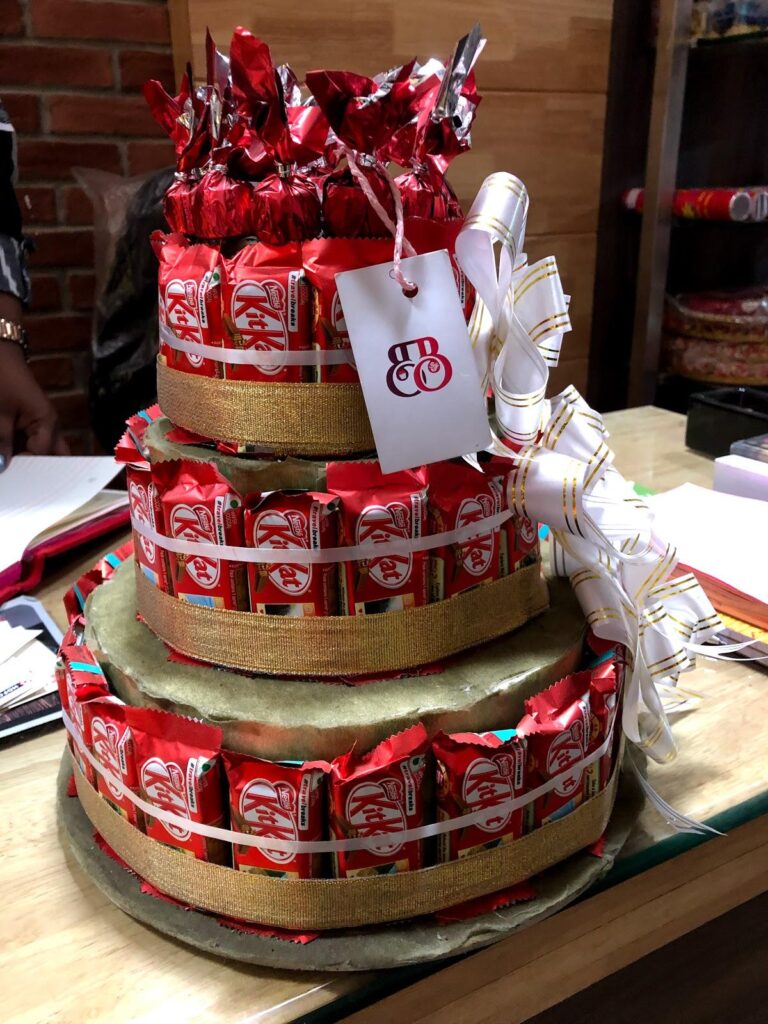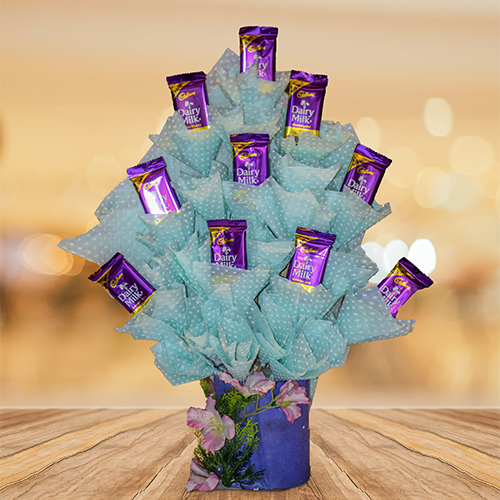
Chocolates
In the past, chocolates were sometimes presented as a token of one’s affection or passion. Ancient Aztecs began the custom of giving chocolate as a gift by serving their warriors, monarchs, and explorers a chocolate drink made from water, spices, and ground cacao beans called Xocolatl. Cacao beans were more highly prized than gold by the Aztecs, who saw them as a divine gift that should be shared among all members of society. About a decade ago, traditional mithai, or sweets, were the only acceptable food gifts to give in India. However, the Indian population’s newfound taste for luxury has gradually reshaped the country’s gift market. Chocolate has been a popular present for many events due to its reliability, opulence, deliciousness, and presentational qualities.
Why Chocolates Make the Best Gift for Any Occasion
In India, giving chocolate as a gift is quickly becoming a custom that not only replaces but also enhances other types of presents. Chocolate, a confection and beverage ingredient derived from cocoa beans, is also used to flavor and coat a wide variety of baked goods. The carbohydrate content makes it a great choice for a quick energy boost, and the trace levels of the stimulating alkaloids theobromine and caffeine add to this effect.
History of chocolate
More than three thousand years ago, the Maya, Toltec, and Aztecs grew cacao trees for their fruit, the cocoa bean, which they used to make a drink (sometimes as a ceremonial drink) and to trade for goods. Mayans buried important people with bowls of chocolate and revered the cacao tree as a sacred plant (along with other items deemed useful in the afterlife). The Maya script was deciphered in large part due to the discovery of the (Olmec-derived) word ka-ka-w (“cacao”) engraved on the containers.
No one knows when or why Spain introduced chocolate to European cuisine, but they were the first. Although his introduction of cocoa beans to Spain on his fourth voyage in 1502 received little attention at the time, it is known that Columbus brought some with him. Many people believe (although there appears to be no evidence) that the Spanish adventurer Hernán Cortés was introduced to the bitter cocoa-bean drink in Spain by Montezuma II, the Aztec king of Mexico, around 1519. The Kekchi Mayan peoplKekchiGuatemala likely brought chocolate to the court of Prince Philip in Spain for the first time in 1544 when they visited. However, the first documented shipment of cocoa beans to arrive in Spain from Veracruz, Mexico, did not do so until 1585. Chocolate, sweetened and flavored with cinnamon and vanilla, became a favorite hot beverage in the Spanish court. It took a long time for chocolate to be introduced to countries like France, England, and the rest of the world.
A Frenchman founded a shop in London selling the solid chocolate needed to make the drink in 1657, and customers paid anywhere from 10 to 15 shillings for a pound of it. Since only the wealthy could afford it, trendy chocolate houses — some of which became illustrious private clubs — sprang up in London, Amsterdam, and other European towns. White’s, which Francis White started in 1693 as White’s Chocolate House, and Cocoa-Tree, which debuted in 1698 as the Cocoa-Tree Club, were two of numerous chocolate houses in London utilized as political party meeting places and high-stakes gambling venues. About 1700, the English added milk to chocolate, making it better. High import charges on the raw cocoa bean delayed chocolate’s rise to popularity in Britain until the middle of the nineteenth century, when they were dropped to a standard amount of one penny per pound.
Meanwhile, chocolate manufacturing went global and became increasingly sophisticated. In 1765, New England ship captains brought back cocoa beans from the West Indies and began producing chocolate in the American colonies. This manufacturing began in Dorchester, Massachusetts. The first mill was owned by John Hanan, an Irish immigrant who received financing from James Baker. To grind the beans, water power was used. In 1828, a Dutchman named C.J. van Houten developed a method for extracting cocoa powder from roasted and ground cocoa beans by squeezing off most of the cocoa butter. Sweet (eating) chocolate, the foundation of most chocolate confectionery, was created in 1847 when the English company Fry & Sons blended cocoa butter, chocolates liquor, and sugar. In 1876, Daniel Peter of Switzerland added dried milk to form milk chocolate. Flavored, solid, and coated chocolate items mushroomed soon after.

Production of chocolate
During the process of making chocolates, the cocoa bean’s kernel is fermented and then roasted. The cocoa beans are ground into a paste called chocolate liquor, which can then be molded into bars of bitter (baking) chocolate, pressed to remove some of the cocoa butter and powdered into cocoa powder, or combined with sugar and more cocoa butter to create sweet (eating) chocolate. To make milk chocolate, sweet chocolate is combined with dried or condensed milk.
Even though it tastes and feels like chocolate, white chocolate is not chocolate. Cocoa butter, milk solids, sugar, and flavorings like vanilla are the basic ingredients in making white chocolate.
Chocolate Gifting Ideas
Make your special someone happy with a homemade chocolate gift basket or box. ROYCE’ Chocolate has many flavor options. To create a unique chocolate gift box, you can pick and choose from among our popular chocolates.
Types of Chocolate
White chocolate, milk chocolate, and dark chocolate are the three most common kinds of chocolate. Each of us has a preferred taste. But how well-versed are you in the various chocolate varieties? Are you familiar with the characteristics that set semisweet candy apart from bittersweet candy? Or, is it the reason white chocolate melts more easily than milk chocolate? Everything depends on the process and quality of the chocolate’s ingredients. Keep reading to get the lowdown on the myriad ways in which chocolates can differ from one another in taste, texture, and other distinguishing features.
Chocolate flavoring
All chocolates begin with chocolate liquor, often known as unsweetened chocolate. Cacao nibs, found on the cocoa bean’s interior, are ground into a thick, dark brown paste. To provide a silky finish, the nibs are finely ground. This paste can be shaped into bars or chips when heated to a temperature where it becomes a liquid. Chocolate liqueur contains only chocolate and nothing else. When subjected to intense pressure, this mixture breaks down into cocoa butter and cocoa powder (also called cocoa solids). Chocolate liquor is a misnomer because it does not have any alcoholic content despite the name.
Get More: Best Gift of plant
White Chocolates
In contrast to milk chocolates, white chocolates have a distinct cream or ivory hue. Sugar, cocoa butter, milk, vanilla, and lecithin are the ingredients (an emulsifier that helps the ingredients blend). White chocolate’s distinctive vanilla flavor comes from these components. In general, white chocolate has a very sugary flavor with strong hints of sweetened condensed milk and vanilla. White chocolate’s high sugar and milk content and cocoa butter foundation give it that signature smooth, velvety texture that’s indicative of great quality.
One of white chocolate’s distinguishing features is that it doesn’t have any cocoa solids like regular chocolate. The cocoa solids are responsible for chocolate’s signature brown color and rich flavor. Guidelines for categorizing various chocolates are established by the Food and Drug Administration of the United States. White chocolate, by their definition, must include at least 20% cocoa butter, 14% milk, and no more than 55% sugar.
So many people wonder, “Is white chocolate even chocolate?” The answer is “yes” because of the presence of cocoa bean-derived components. Be wary of the vanilla or white-flavored coating commonly seen on low-quality goods. The high cost of cocoa butter can be attributed to its widespread use in lotions and other beauty products. To avoid the high cost of cocoa butter, several manufacturers produce a compound with a lower melting point. While they may taste similar to white chocolate, products that fall short of the FDA’s definition of white chocolate typically contain less than 20% cocoa butter. White chocolate has a shelf life of roughly four months if stored properly. White chocolate is wonderful for eating, but it is also useful in the kitchen, bakery, and decorating. To any recipe, the flavor profile of dairy will lend a delicate richness while still allowing other flavors to show through. The pale hue of white chocolate is ideal for sprinkling over finished desserts. This white chocolate and coconut ganache is a great introduction to cooking with white chocolate.
Milk chocolates
All of us have fond childhood memories of milk chocolate. Most people agree that milk chocolate, with its pale brown hue, smooth texture, and somewhat sweet taste, is the best kind of chocolate. Chocolate liqueur is created by mixing sugar and milk with cocoa powder and cocoa butter. As an emulsifier, soy lecithin is sometimes used to make it even silkier. At least 10% chocolate liquor and 12% milk must be included for a product to be considered “milk chocolate” according to the Food and Drug Administration.
The milk chocolate smell will permeate the room if you just break off a piece. Smell the delicious blend of vanilla, chocolates, and fresh dairy. Then, take a bite and let the flavor wash over your taste buds. Sweet and chocolatey, with hints of cooked milk and caramelized sugar and a vanilla aftertaste, milk chocolate is a common type of chocolate found in many chocolate bars.
Milk chocolate is widely regarded as a delicious compromise. Its typical sweetness and softer texture set it apart from dark chocolates, but it’s not nearly as sweet or pliable as white chocolates. If stored properly, milk chocolate can keep for around 16 months. When you’re looking for a chocolate treat or present that virtually everyone will like, milk chocolates are a safe bet. You may use it in baking whenever you need a less intense chocolate flavor, such as in these chocolate waffles.
Dark Chocolate
Dark chocolates, so named for their distinctively dark brown hue, are the second most popular variety of chocolate. Less sweet than milk chocolate, this variety is frequently referred to as “black” or “semisweet.” Recent years have seen a meteoric rise in the popularity of dark chocolate as a result of numerous publications touting its health benefits.
The components of dark chocolate are straightforward. Typically, chocolate liquor and sugar are the only two components. Soy lecithin (an emulsifier) and vanilla extract (a flavoring) are sometimes tucked in there, too. Dark chocolates, as defined by the FDA, must contain at least 15% chocolate liquor, however, the typical amount is closer to 50%. The vast majority of high-quality dark chocolates do not have any added dairy and are, therefore, suitable for vegans. Dark chocolate has a harder texture than milk chocolates or white chocolate due to the lack of dairy and less sugar. This is why a bar of high-quality dark chocolate should crack cleanly in two when you break it.
Dark chocolate’s flavor profile varies greatly depending on the cocoa percentage of the chocolate. Typical flavors include baked brownie, red fruit, and brown spice, with a hint of sweetness (think cinnamon or allspice). Dark chocolate’s strong chocolate taste makes them an excellent ingredient when a recipe calls for a deep chocolate accent. These traditional brownies and this chocolate bourbon maple pecan pie are must-tries. As a result of its many touted health benefits, dark chocolate is a popular choice among those looking to nibble on something nutritious. It has a shelf life of roughly 20 months if stored correctly.
Get More: All types bouquets
Bittersweet chocolate
Bittersweet chocolate has become increasingly popular as consumers become more educated about the differences between cacao and cocoa. Dark chocolate with a cocoa content of 70% or more, often known as extra-dark chocolate, gained popularity when it was suggested that doing so would maximize health advantages. An increase in the popularity of dark chocolate with a greater cocoa content can be attributed to the recent boom in bean-to-bar chocolate makers and craft chocolate.
According to the FDA, both semisweet and bittersweet chocolates must contain at least 35% chocolate liquor, with the latter typically containing at least 50% cocoa liquor. Dark chocolate with a cocoa level of 66% or more is considered bittersweet.
Bittersweet chocolates, as their name suggests, are typically a touch more bitter than semisweet dark chocolate. Depending on where the cacao is harvested, the resulting chocolate may have a fruity or earthy flavor or even hints of baked goods like brownies. In baking, you can use either bittersweet or semisweet sugars, depending on what you desire. Using bittersweet chocolates as a substitute will alter the sweetness and depth of the chocolate taste in the dish. Try it in brownies, fudge, or a molten chocolate cake. When kept under the right conditions, the shelf life of extra-dark chocolates is around 20 months.
Ground Cocoa Beans
Chocolate powder is made by extracting the cocoa solids from the chocolate liquid and grinding them into a fine powder at high pressure. The cocoa content of unsweetened cocoa powder is close to 100%. We can choose between natural cocoa powder and dutch-processed cocoa powder while making chocolate. To the untrained eye, natural cocoa has a lighter brown hue and a richer, typically more acidic chocolate flavor. Natural Dutch cocoa has been alkalized to remove its acidity. The dutch technique produces cocoa powder with a rich, golden hue and a more subdued flavor.
Baking with unsweetened cocoa, especially Dutch chocolate, is a wonderful experience. To enhance the rich chocolate flavor of a recipe like this ultimate chocolate cake, try using this ingredient. Cocoa powder, unsweetened, can be used to enhance the flavor of spice rubs and moles. The extra processing of Dutch-processed cocoa makes the powder easily blendable with liquids, making it a common choice for preparing hot chocolate. Unsweetened cocoa has a shelf life of around 18 months if stored correctly.
Chocolates Ruby
Belgian chocolate producer Barry Callebaut discovered a fourth type of chocolate, ruby chocolate, in 2017. This one-of-a-kind chocolate stands out from the crowd thanks to its eye-catching reddish-pink tint. Color comes not from added food dyes but rather from the ruby cocoa bean (a bean typically grown in Ecuador, Brazil, and the Ivory Coast.) Since this is such a novel finding (and the specifics of the cacao-making technique devised by Barry Callebaut are confidential), the FDA has yet to establish a term for it.
Ruby cacao, with its 47.5% cacao content and 26.3% milk, boasts aromas of rich fruitiness and fresh acidic undertones. With this trendy new cacao kind, you can make vibrant, fruit-forward chocolate delights that are perfect for sharing on social media. Ruby cacao has a shelf life of up to 12 months with optimal storage conditions.


Got best chocolate Delivered for my friend and she loved it.